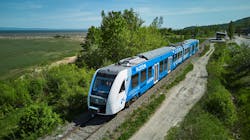Alstom debuts H2-powered Train for Quebec Railway
Manufacturer Alstom has introduced a new hydrogen-powered train to operate on the Réseau de Charlevoix railway network in Quebec this summer.
Alstom has partnered with the Government of Quebec, Chemin de fer Charlevoix, Train de Charlevoix, Harnois Énergies, HTEC and Accelera by Cummins to introduce the Coradia iLint hydrogen train to operate commercially on the line.
"Hydrogen technology offers an alternative to diesel and demonstrates our ability to provide more sustainable mobility solutions to our customers, agencies and operators, as well as passengers," said Michael Keroullé, President of Alstom Americas. “It will also provide an extraordinary showcase for Quebec’s green hydrogen ecosystem, which is under development.”
The hydrogen train generates its own energy using fuel cells supplied by Ontario-based Accelera by Cummins and is powered by green hydrogen produced by Harnois Énergies at its Quebec City site.
"The hydrogen used will be produced at our Quebec City station and will then be transported via high-pressure tanks to Baie St-Paul," said Serge Harnois, President and CEO of Harnois Énergies.
See our full coverage of E-Mobility movements in the Railway Industry
EnergyTech stories on Hydrogen Fuel Cells in the Transportation sector
The train can move at a speed of 140 km/h and is powered by a hydrogen fuel cell that emits only water vapor during operation, thus ensuring a quieter environment. Designed for non-electrified lines, the train offers clean energy conversion, flexible energy storage in batteries, smart traction and energy management.
Hydrogen does not contain carbon in its composition and thus does not emit carbon dioxide when combusted. However, it is not easily collected so must be generated either by separation from methane gas or by electrolyzers using electricity to split the H2 from water.
The first priority of Alstom’s innovation center in Saint-Bruno-de-Montarville is the commercial operation of the Coradia iLint in Quebec. The primary mission of the center to develop future platforms with hybrid, battery or green hydrogen propulsion specifically adapted to the North American market will allow more than 700 Alstom Quebec engineers fasten the decarbonization of the rail sector.
The Hydrogen Research Institute of the Université du Québec à Trois-Rivières and Alstom will analyze results of developing an ecosystem for hydrogen propulsion technology and its penetration into the North American market, through the commercial operation of this train.
“As Accelera continues to innovate, we’re guiding customers through energy transition roadmaps by providing end-to-end hydrogen solutions,” said Alison Trueblood, General Manager of Fuel Cell and Hydrogen Technologies at Accelera. “This includes advancing traditional transportation methods, like passenger trains, through the adoption of zero-emission technologies and enabling industry infrastructure with hydrogen-producing electrolyzers. Together with Alstom and many other partners, we are advancing hydrogen propulsion technology in the North American market.”
